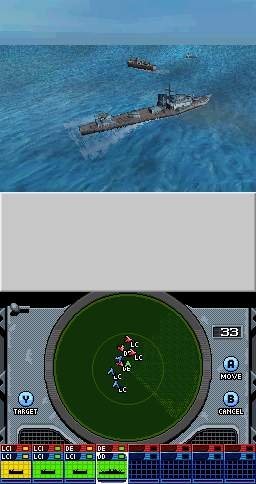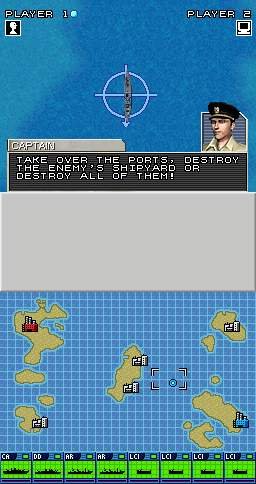Steel Horizon is a naval "strategy" game put out by Konami for the Nintendo DS. However, there really isn't much strategy involved. In fact, there really isn't much of anything to this game at all, as it's painfully straightforward, often unwieldy, and utterly dull. Other than a decent storyline, fans of turn-based strategy games will find little to like, and much to loathe, about Steel Horizon.

This may or may not come as a surprise to you, but Hitler was kind of insane. This and other history lessons are du jour in Steel Horizon, which presents a fairly entertaining narrative on the occult aspects of WWII that's comparable to anything you might find in an Indiana Jones movie or Hellboy comic. The story is noteworthy, even commendable, in that it doesn't devolve into the typical American military brouhaha, as both German and Japanese soldiers are portrayed in an honorable light altogether separate from the megalomaniacal urges displayed by higher-ups on all sides of the conflict. It's a story worth telling, which is why it's a crying shame that few will be able to withstand the gameplay long enough to see its end.
Steel Horizon's greatest flaw is that for a strategy game, it comes up woefully short on the strategy. Aside from your one flagship that you begin the game with, you aren't able to upgrade your fleet, so you'll deploy the same ships throughout the game without variation. Resources, which are used to purchase ships, accrue by controlling shipyards scattered about the map, but these are never particularly scarce, and you'll only come up wanting in the very beginning of each stage. Ships come in 14 different flavors, but you'll pragmatically settle on three or four ships to flesh out your fleet. This is, of course, unless you become saddled with ships you don't want, which frequently occurs. Most missions will start you off with an entire host, including many ships you'd never intentionally commission. Since you can't scuttle or dock them, your only recourse is to either send them to the wolves, which is as much a hassle as it is a time sink, or ignore them completely.
This isn't to say you'll need all eight of those groups, though, as missions won't tax your frontal lobe in the least. A balanced flotilla will sink anything you run up against, and the enemy artificial intelligence isn't that good, so you'll typically always have the upper hand. In fact, the enemy AI can be downright terrible at times, because it regularly avoids exploiting matchups and will ignore an obvious threat in pursuit of a smaller, inoffensive bounty. There's also not much variety to liven up the experience. By the fifth mission of going up against the same enemies with the same outfit under the same terms for victory, you may get a bit antsy. By the 10th, you'll wonder if the story's conclusion is really worth seeing this thing out. By the 15th, your eyes will take on a zealous glint as you stubbornly and wantonly fling yourself into the next mission. And by the 20th hour-long mission, you'll be bobbing your head, agreeing with the robed men that humanity must die.
Perhaps to differentiate itself from the crowd, Konami thought it might be a good idea to incorporate some button-mashing elements into the game's battle sequences. Instead of just quickly simming each encounter, as those who play these types of turn-based strategy games are used to, you'll instead have to endure a 60-second battle that essentially involves you cycling through your ships and hitting the X button when prompted to fire your guns. You're technically also able to reposition your ship, but it's difficult to judge where you're going on the map, and the encounter area is too small and the battles are too short for it to matter much anyway.
Steel Horizon will occupy a significant amount of your time if you let it. Each of the 20 missions average between 45 minutes to an hour, with the vast majority of that time being spent traversing the open seas, sailing a few uneventful squares at a time. Granted, hypoxia-inducing action isn't typically a part of the strategy-game formula, but the problem here is that it just takes too long to do anything. This is mainly because there's some kind of lag or processing delay on all of your actions, which becomes excessively irritating extremely fast. It also doesn't help that you'll be digging through a good deal of menus, as everything from moving to attacking to altering the orientation of your ship is buried somewhere. The DS's touch screen could have been used to greatly streamline the process, but its functionality is limited to movement once you've indicated your intent in a menu, and even then you can play the entire game without using it at all.
But wait, there's more. If you wanted to see what the game would be like without its one redeeming quality, you can subject yourself to 21 skirmish missions that are by and large exactly like the 20 missions in the story mode, sans the story. If you and a like-minded individual who also has a cart are so inclined, local multiplayer is also an option. With the way turns play out, it would have been functionally possible to just pass the DS back and forth. And be sure to have a DS charger handy, because as long and drawn out as the single-player missions are, multiplayer takes that much longer. With both of these modes, it would have been nice to at least be able to use the flagship you improved over the course of the single-player campaign. As it is, you just start out with generic ships.
Aside from a few nice-looking cinematics, Steel Horizon doesn't have a particularly remarkable look. The overhead grid is pretty much what you'd expect from a strategy game. Though you'll play in both the Pacific and Atlantic, environments in the battle sequences all look the same--which is to say, there's a lot of ocean and nothing else. There are a fair number of pixelated explosions during these sequences, and you can see torpedoes skim through the water and airplanes in the sky. It's a bit disappointing to see ships just sink instead of breaking apart or blowing up, though. The presentation really takes a hit with the game's interface, which is sorely lacking. There are no onscreen indicators of your ships' health other than ambiguous colors; when you move, you lose sight of the global map, so it's easy to get disoriented; there's the slight delay discussed above; and information on the various ships you had no intention of ever sailing is buried in menus and often incomplete, among other things. Likewise, the game sounds really, really bad. A single maritime march loops for the vast majority of the game, and combat noises have never sounded so passive.
The DS isn't exactly flush with good turn-based strategy games, and Steel Horizon certainly doesn't come close to games like Advanced Wars or Age of Empires. The strategy is mindless and easy, the interface is cumbersome and annoying, and the presentation is lacking. While the story isn't Pulitzer-worthy, it's at least a lot better than what most games offer. But by no means should you play this game just to check it out. That would be a very bad idea.
